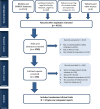Patient safety initiatives in obstetrics: a rapid review
- PMID: 29982200
- PMCID: PMC6042535
- DOI: 10.1136/bmjopen-2017-020170
Patient safety initiatives in obstetrics: a rapid review
Abstract
Objectives: This review was commissioned by WHO, South Africa-Country office because of an exponential increase in medical litigation claims related to patient safety in obstetrical care in the country. A rapid review was conducted to examine the effectiveness of quality improvement (QI) strategies on maternal and newborn patient safety outcomes, risk of litigation and burden of associated costs.
Design: A rapid review of the literature was conducted to provide decision-makers with timely evidence. Medical and legal databases (eg, MEDLINE, Embase, LexisNexis Academic, etc) and reference lists of relevant studies were searched. Two reviewers independently performed study selection, abstracted data and appraised risk of bias. Results were summarised narratively.
Interventions: We included randomised clinical trials (RCTs) of QI strategies targeting health systems (eg, team changes) and healthcare providers (eg, clinician education) to improve the safety of women and their newborns. Eligible studies were limited to trials published in English between 2004 and 2015.
Primary and secondary outcome measures: RCTs reporting on patient safety outcomes (eg, stillbirths, mortality and caesarean sections), litigation claims and associated costs were included.
Results: The search yielded 4793 citations, of which 10 RCTs met our eligibility criteria and provided information on over 500 000 participants. The results are presented by QI strategy, which varied from one study to another. Studies including provider education alone (one RCT), provider education in combination with audit and feedback (two RCTs) or clinician reminders (one RCT), as well as provider education with patient education and audit and feedback (one RCT), reported some improvements to patient safety outcomes. None of the studies reported on litigation claims or the associated costs.
Conclusions: Our results suggest that provider education and other QI strategy combinations targeting healthcare providers may improve the safety of women and their newborns during childbirth.
Keywords: knowledge synthesis; medical malpractice; obstetrics; patient safety; quality improvement; review.
© Article author(s) (or their employer(s) unless otherwise stated in the text of the article) 2018. All rights reserved. No commercial use is permitted unless otherwise expressly granted.
Conflict of interest statement
Competing interests: None declared.
Figures


References
-
- Kohn LT, Corrigan JM, Donaldson MS. To err is human: building a Safer Health System. 6: National Academies Press, 2000. - PubMed
-
- World Health Organization. Guide for developing national patient safety policy and strategic plan. 2014.
-
- American College of Obstetricians Gynecologists. Patient safety in obstetrics and gynecology. ACOG Committee Opinion No. 447. Obstet Gynecol 2009;114:1424–7. - PubMed
Publication types
MeSH terms
Grants and funding
LinkOut - more resources
Full Text Sources
Other Literature Sources
Medical
Miscellaneous
